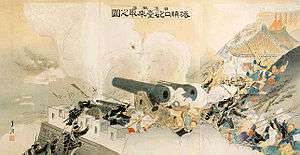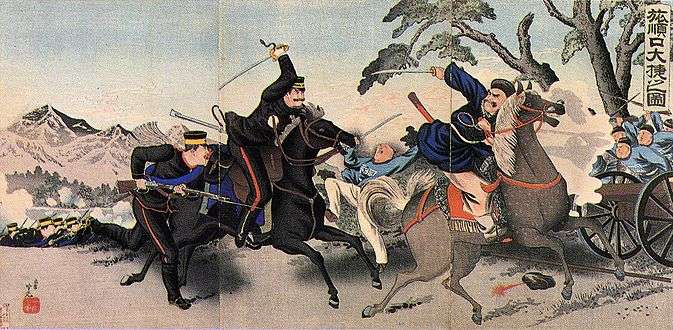Battle of Lushunkou
| Battle of Lüshunkou | |||||||
|---|---|---|---|---|---|---|---|
| Part of the First Sino-Japanese War | |||||||
 Japanese troops storming the citadel of Lushunkou. | |||||||
| |||||||
| Belligerents | |||||||
|
|
| ||||||
| Commanders and leaders | |||||||
|
|
| ||||||
| Strength | |||||||
| 15,000 | 13,000 | ||||||
| Casualties and losses | |||||||
|
29 killed 233 wounded | 4,500 killed | ||||||
The Battle of Lüshunkou (Chinese: 旅順口之戰; Japanese: Ryōjunkō-no-tatakai (旅順口の戦い)) was a land battle of the First Sino-Japanese War. It took place on 21 November 1894 in Lüshunkou, Manchuria (later called Port Arthur, in present-day Liaoning Province, China) between the forces of the Empire of Japan and the Empire of China. It is sometimes referred to archaically in western sources as the Battle of Port Arthur (that name is now primarily used for the opening battle of the Russo-Japanese War in 1904).
Background
Following the Battle of Jiuliancheng at the Yalu River, and subsequent minor engagements in the Liaodong Peninsula, the strategic aim of Japan was to seize the heavily-defended and strategically important naval base of Lüshunkou, known in the West as "Port Arthur". This naval station had taken the Qing government sixteen years to build, and was considered superior to Hong Kong in its facilities. Defended by its hilly terrain and strengthened with fortifications and powerful artillery, it was widely considered to be an impregnable stronghold. Lüshunkou was also the only facility with dry docks and modern equipment capable of repairing the warships of the Beiyang Fleet, and its loss would mean that China would no longer have the capability to repair any ship damaged in combat.[1] The location of Lüshunkou, at the entrance to the Gulf of Bohai also meant that it controlled the sea approaches to Beijing.
The battle
The Imperial Japanese Army's Japanese First Army under the overall command of Ōyama Iwao divided into two groups, with one group marching north as a diversion to threaten the Qing ancestral capital of Mukden, and the other marching south down the Liaodong Peninsula towards Lüshunkou. The Imperial Japanese Army’s Japanese Second Army, with Lieutenant General Baron Yamaji Motoharu and General Nogi Maresuke landed at Pi-tse-wo (present day Pikou, Liaoning Province, China) on 24 October 1894. On 6 November 1894 Nogi's forces took the walled town of Jinzhou with very little resistance. The Liaodong Peninsula narrowed to only a 2.5-mile (4 km) width just past Jinzhou, so with the town in Japan’s hands, Lüshunkou became isolated from its landward approaches.[1]
The following day, on 7 November 1894 Nogi marched into the port town of Dalian with no resistance, as its defenders had fled to Lüshunkou the previous night. The intact capture of the dock facilities greatly facilitated Japanese supply lines, as in their haste to depart, the defenders had even left behind plans to the minefields and details to the defenses of Lüshunkou.[1] To make matters worse for the defenders of Lüshunkou, the Beiyang Fleet had received orders from Viceroy Li Hongzhang (based in Tianjin) to withdraw to Weihaiwei rather than risk engagement with the Imperial Japanese Navy, and was thus not able to play any role in the defense of their base. Worse still, when withdrawing from Lüshunkou, the flagship of the Beiyang Fleet, the battleship Zhenyuan, struck rocks at the entrance of Weihaiwei harbor and had to be beached. As the only docks capable of making repairs were at Lüshunkou, this effectively put it out of commission for the remainder of the war.[1]
Skirmishing on the outskirts of Lüshunkou began on 20 November 1894, creating a panic among the defenders resulting in looting and destruction of property. Most of the Qing officers fled on two small boats which remained in port, leaving their men to their fate.
The assault on Lüshunkou began after midnight on 21 November 1894. Under heavy fire, the Japanese forces had stormed all of the important landward defenses by noon the following day. The shore fortifications held out a bit longer, but the final one fell to the Japanese by 1700 hours. During the night of 22 November 1894, the surviving Chinese defenders deserted their remaining positions, abandoning 57 large-caliber and 163 small-caliber artillery pieces. The fortifications, dockyards and a large supply of coal were captured largely intact by the Japanese.
When the Japanese forces entered the city, they were fired upon from houses where Chinese soldiers had hidden themselves and had put on civilian dress so as to better blend in with the local population. The Japanese responded with a house-to-house search, killing many adult males who offered resistance.
Chinese casualties were officially estimated at 4000 killed. The Japanese lost only 29 men killed, 233 wounded.
Aftermath of the battle

The speed of the Japanese victory at Lüshunkou was regarded as a turning point in the war by contemporary Western observers and was a strong blow to the prestige of the Qing government. The Chinese government responded by denying that the naval base had fallen, and stripped Li Hongzhang of his official titles.
However, Japanese prestige over the victory was tempered by accounts of widespread massacre of the Chinese inhabitants of the city by victorious Japanese troops, allegedly in response to the torture and murderous treatment the Chinese had shown Japanese prisoners of war at Pyongyang and elsewhere. The report, was highly controversial, as other correspondents present initially denied that such events had occurred, out of fear of the Japanese. News of a massacre soon spread among the Western public, damaging Japan's public image and nearly torpedoing ongoing efforts by Japan to renegotiate the unequal treaties with the United States. The event came to be popularly known as the Port Arthur massacre.
Notes
References
- Chamberlin, William Henry. Japan Over Asia, 1937, Little, Brown, and Company, Boston, 395 pp.
- Japan An Illustrated Encyclopedia, 1993, Kodansha Press, Tokyo ISBN 4-06-205938-X
- Lone, Stewart. Japan's First Modern War: Army and Society in the Conflict with China, 1894–1895, 1994, St. Martin's Press, New York, 222 pp.
- Paine, S. C. M. The Sino-Japanese War of 1894–1895: Perception, Power, and Primacy, 2003, Cambridge University Press, Cambridge, MA, 412 pp. ISBN 0-521-61745-6
- Warner, Dennis and Peggy. The Tide At Sunrise, 1974, Charterhouse, New York, 659 pp.
External links
Coordinates: 38°49′N 121°14′E / 38.817°N 121.233°E